Casio Unveils Prototype of Visible Light Communication System Using Smartphones at CES
TOKYO, January 10, 2012 — Casio Computer Co., Ltd., announced today that it will exhibit a prototype visible light communication system using smartphones at the Consumer Electronic Show to be held January 10-13, 2012 in Las Vegas.
Visible light communication (VLC) is a technology that transmits digital signals by flashing light in frequencies that are visible to the naked eye. VLC has potential applications in many fields including augmented reality, since it can use a wide range of light-producing sources including monitors, LED lighting and signage, and because it can be read from a distance without impacting people or electronic equipment.
Casio has been a member of the Visible Light Communications Consortium since it was initiated in 2004 to facilitate the spread of VLC and standardization of the technology. In addition to pursuing fundamental research and standards development for VLC, Casio has been developing applied technology for receiving signals through the use of image sensors such as C-MOS and CCD sensors. Casio’s image sensor communications technology can determine the point of data transmission while simultaneously receiving many signals.
Casio has used its image sensor communications technology to develop a prototype smartphone VLC system for consumer and commercial applications. The prototype system demonstrates how Casio aims to broaden the application of VLC and propose specific uses for it, with the goal of driving rapid adoption of VLC in real-world applications.
Details of Prototype System
Smartphone-to-smartphone communication
The system flashes smartphone screens to achieve visible light communication (VLC). When someone takes a photo with a smartphone camera, the subjects simply turn their smartphone screens toward the camera device to display personal information or messages in the photo. The images and information are shared on the spot among everyone’s smartphones, so that it can be combined with social media to simultaneously “make friends” while taking photos.
●Can simultaneously receive data from up to five smartphones for display in a single photo
●Displays message balloons of up to 120 characters, with customizable balloon shapes and image frames
●Automatically saves information on the photo taker’s smartphone, such as e-mail addresses, telephone numbers, and social network usernames
●Twitter upload tweets the image containing the messages
 |
 |
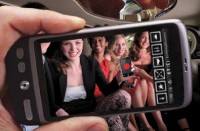 |
 |
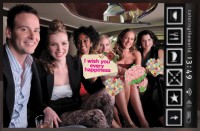 |
| Data is transmitted from each the smartphones | Your smartphone reads the data transmitted from the other smartphones | The visuals appear where the smartphones are located |
Information transmission to smartphones using LED and digital signage
A system that enables users to receive information from a shop or advertiser, by viewing digital signage or an LED light source placed in front of the shop through a smartphone camera. The information can be received from a remote location, as long as the camera can detect the flashing light. Shops can start using their existing monitors to disseminate information right away, only needing to dedicate a small area* to flash the light.
*. A 10 cm2 light source is recognizable at distances up to 10 meters and is equivalent to approximately 2.1% of the area of a 42-inch monitor.
●Displays messages, URLs, images or other information on smartphones
●Displays information in real time, such as for time-sensitive advertising
●Disseminates information in-store and to pedestrians, using just a small light source
●Uses existing monitors to start disseminating information with minimal effort
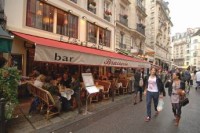 |
 |
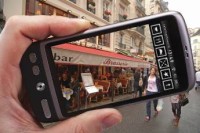 |
 |
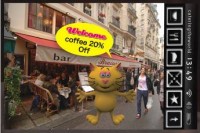 |
| Data is transmitted from an LED set up near the store | Viewing through a smartphone | Display of visual in front of the store |
"Twitter" is a registered trademark of Twitter, Inc.
